The Path to Success
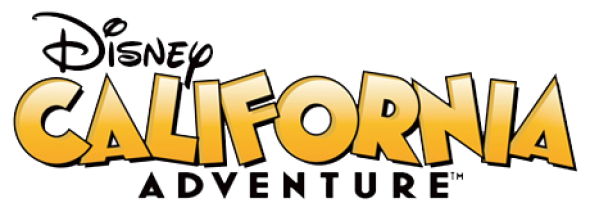
The unprecedented “five year plan” for Disney California Adventure was a bold one, supposing that when all was said and done in 2012 or so, Disneyland’s second gate stood a chance of serving as a counterpart and companion to its older sister. And unlike piecemeal evolutions of EPCOT or Disney’s Hollywood Studios that had seen park identities even further muddied by ad hoc additions and gap-filling, the reimagining of Disney California Adventure would be an all-at-once, master-planned, intentional reboot, providing the park with a coherent “voice” underlying it all.
As an early indication of that new, thoughtful foundation, in 2010 a refreshed identity was rolled out for the under-construction second gate: a slightly edited name (Disney California Adventure, dropping the possessive ‘s in alignment with corporate branding) and a new logo (above, at once encapsulating a classic-yet-cartoonish look appropriate for the new park.) It was clear that Disney meant business when it came to “DCA 2.0.” The path to get there, however, wouldn’t be easy… or wide.
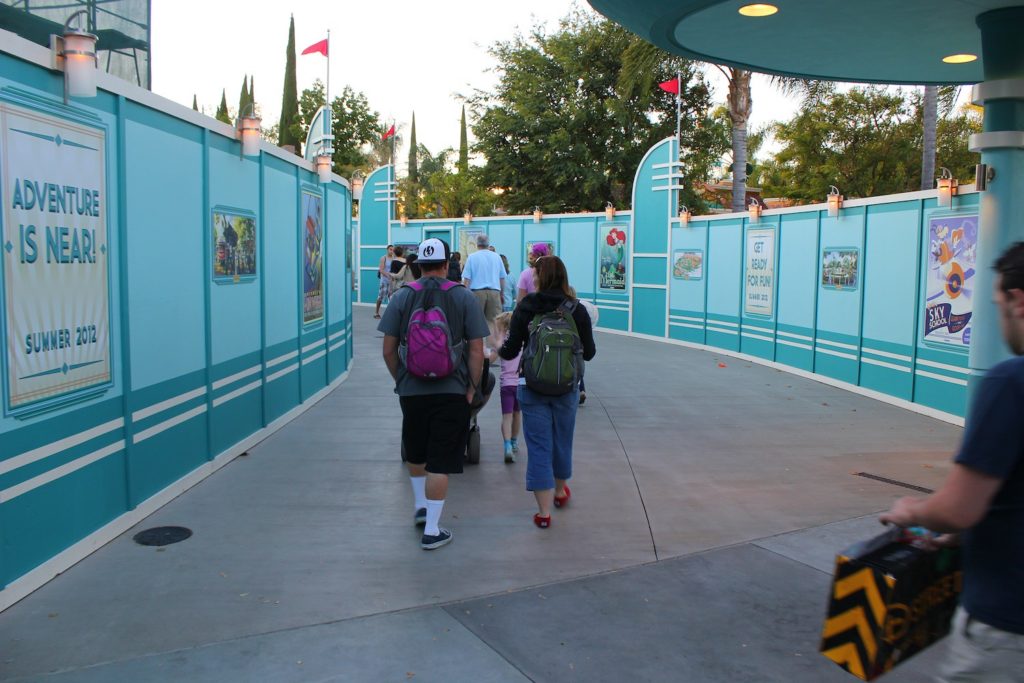
For five years, the park was a sea of pinched construction-wall-lined corridors, routing guests around repainting, re-cladding, construction zones, steel and rebar, active cranes, emptied waterways, and even entirely-stripped lands. Adorned with versions of Mickey and friends in their ’20s and ’30s, pie-eyed style and decked out in art deco accents, those walls – teal, burgundy, goldenrod, and beige – established a new color palette and atmosphere.
First, elements of Paradise Pier went under the knife, with construction walls routing guests around an emptied Paradise Bay, a demolished Golden Dreams theater, a stripped “Route 66” roadside restaurant area of giant hamburgers and surf shacks, and several construction crews tending to re-themed flat rides. Greenery, gingerbread trim, wooden lattices, and clapboard siding began to grow over the walls.
In the Hollywood Pictures Backlot, guests spent months routed down the center of “Hollywood Blvd.” as the facades along either side of the street were restructured; then, construction walls moved to the street’s center to install trolley tracks, routing guests up onto the sidewalks.
Like mice in a maze, guests found fences blocking access to the Bountiful Valley Farm – where steel and rebar were growing into the veritable mountain range of Cars Land – and Grizzly Peak – where major placemaking was shifting the land’s timeline.
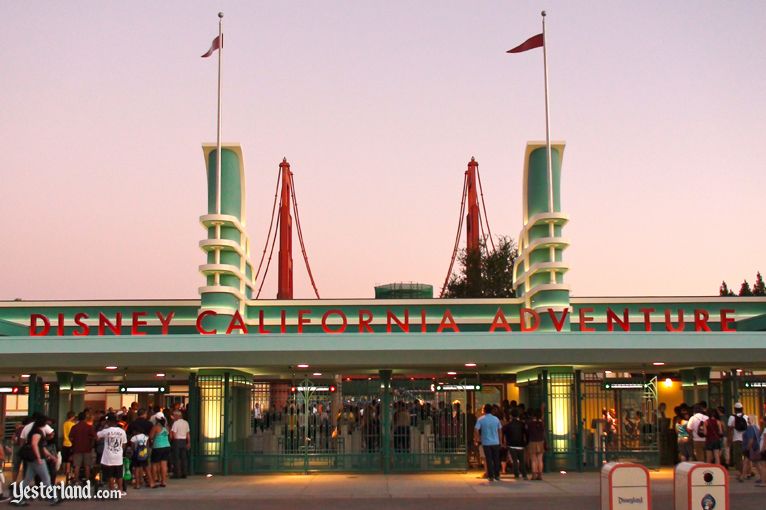
In summer 2011, Sunshine Plaza closed forever. A new entry gate set several yards out from the original turnstiles – the soaring, teal towers of the Pan-Pacific Auditorium – sprung up seemingly overnight. For just a few weeks, the cartoonish Golden Gate Bridge of the park’s retired “postcard” entry remained beyond (above) – a juxtaposition of “DCA 1.0” and “2.0” apparent to all who entered this park in transition… But by July 2011, it was gone, too, as work began in earnest on the new Buena Vista Street.
As a result, after passing through the brand new turnstiles, guests found themselves not staring down a “Main Street,” but at a construction wall blocking the path forward. Instead, they were routed to the right, passing through backstage roadways behind the Soarin’ showbuilding and entering the park proper in Grizzly Peak.
It’s difficult to convey just how much of a trip to California Adventure between 2007 and 2012 was spent navigating narrow passages between plywood walls.
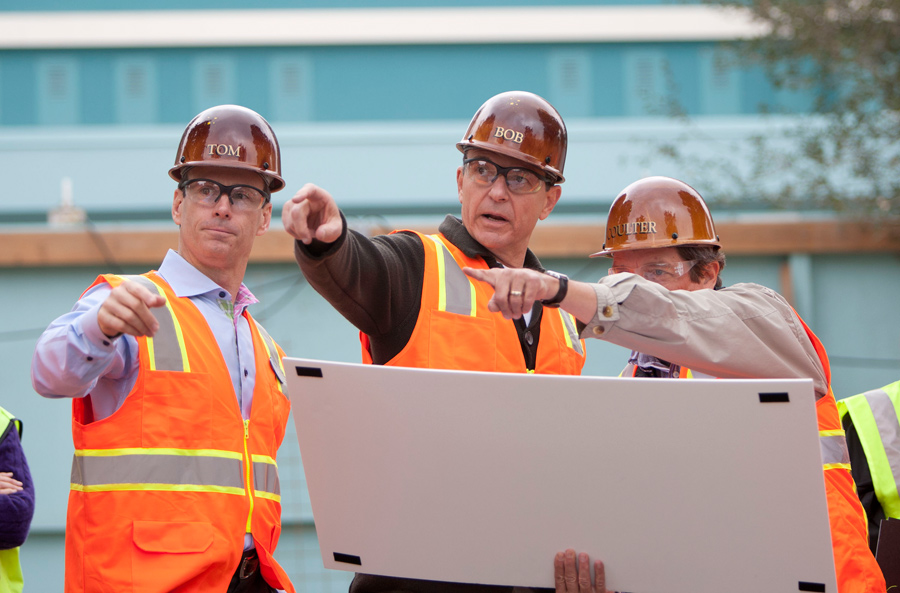
Systematically dismantling the park’s themed lands to the figurative (and in places, literal) studs, Imagineers set to work reorienting each of the park’s modern “districts” into reverent, historic, idealized, romanticized “lands” – the same conceptual framework as Disneyland’s. Seemingly every few months, more and more scrims fell away to reveal refreshed environments, rethemed rides, or long-awaited debuts.
By the dawn of 2012, just two projects remained behind walls: Buena Vista Street and Cars Land. Disney California Adventure closed for a single day – June 14, 2012 – as the finishing touches were placed on the park, navigational signage was updated, and any remaining construction walls were hauled away after five years in constant use. That single day of closure was also a symbolic one.

When Disney California Adventure re-opened the next day – June 15, 2012 – Disneyland’s second gate looked a world away from the one that had launched just over eleven years earlier. The eras of “Band-aid” fixes from 2002 to 2006 and the focused reinvention of 2007 to 2012 had culminated into something once unthinkable: a Grand Re-Opening and a new park dedication delivered by Bob Iger.
“To all who come to this place of dreams: welcome. Disney California Adventure celebrates the spirit of optimism and the promise of endless opportunities, ignited by the imagination of daring dreamers such as Walt Disney and those like him who forever changed – and were forever changed by – The Golden State. This unique place embraces the richness and diversity of California… Its land, its people, its stories and, above all, the dreamers it continues to inspire.”
Welcome to the new Disney California Adventure. Let’s take a walk through the spectacular theme park reborn of the ashes, and let’s see if this new, one-day-old park has become a fitting complement to Disneyland…
Buena Vista Street

Our first indication that things have changed is a grand one. The well-known “postcard” style entrance to the old California Adventure has vanished, taking with it each layer that made up that “postcard” view: the 11-foot tall letters spelling out C-A-L-I-F-O-R-N-I-A, the encompassing ceramic tile murals of California’s manmade and natural wonders, the stretched-and-skewed Golden Gate Bridge the Monorail passed over, and even the bronze Sun Icon appearing to rise behind them all.
Now, the park’s entrance is marked by the soaring, streamlined teal towers of the Pan-Pacific Auditorium – the long-lost Los Angeles landmark that also serves as the entrance to Disney’s Hollywood Studios in Florida. These iconic towers aren’t just a fitting entrance for this Californian park; they’re a classic counterbalance to the historic Main Street Train Station they stand opposite, and evidence of a real effort to make California Adventure a mirrored counterpart to Disneyland instead of a visual clash and stylistic divergence.
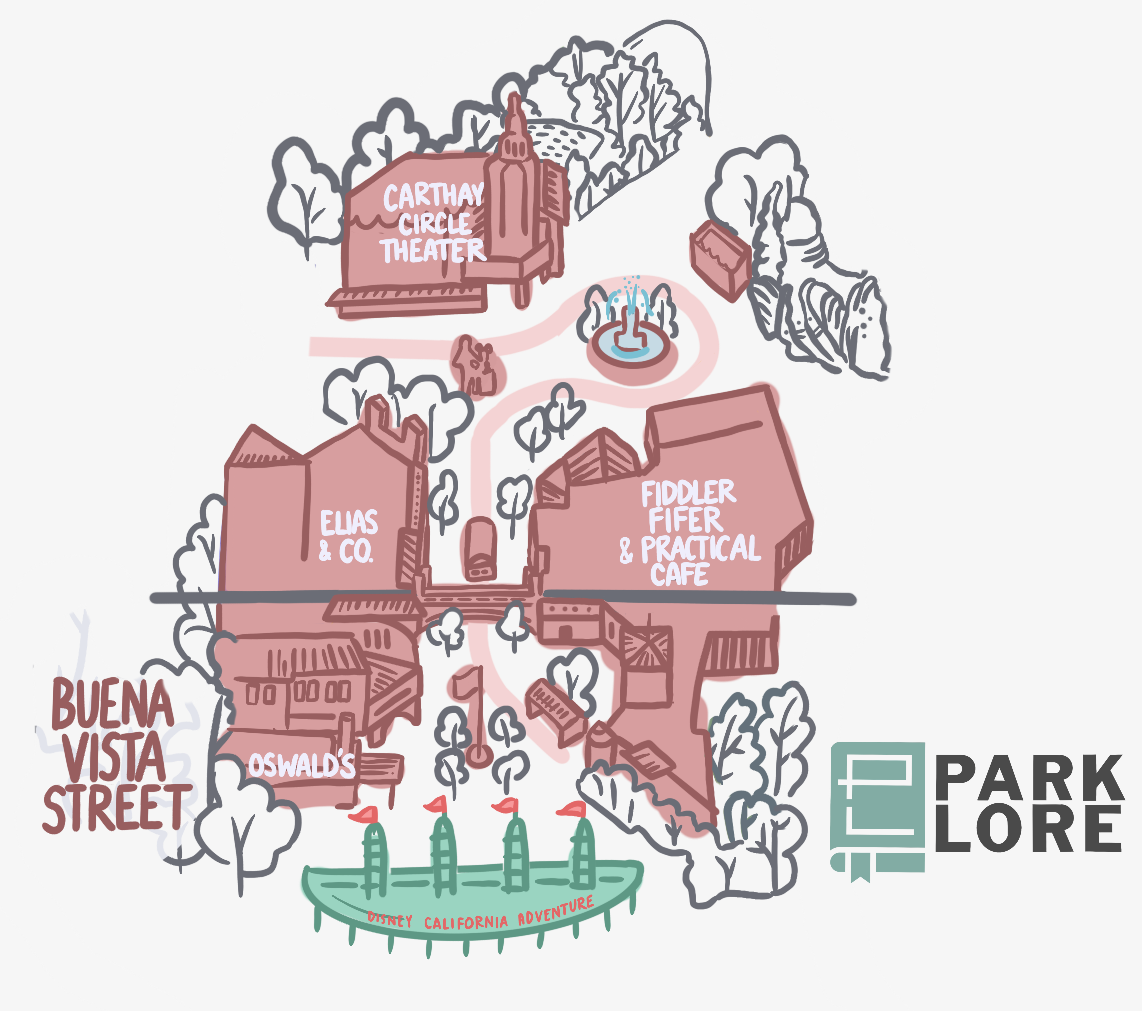
And it is. Beyond the Pan-Pacific Gates, Sunshine Plaza has been mercifully razed, its existing shops rewrapped and unrecognizable. While Disneyland features Main Street, U.S.A. (a turn-of-the-century Midwest town, idealized and perfected as if from the eyes of a child), California Adventure now features a Californian equivalent: Buena Vista Street.
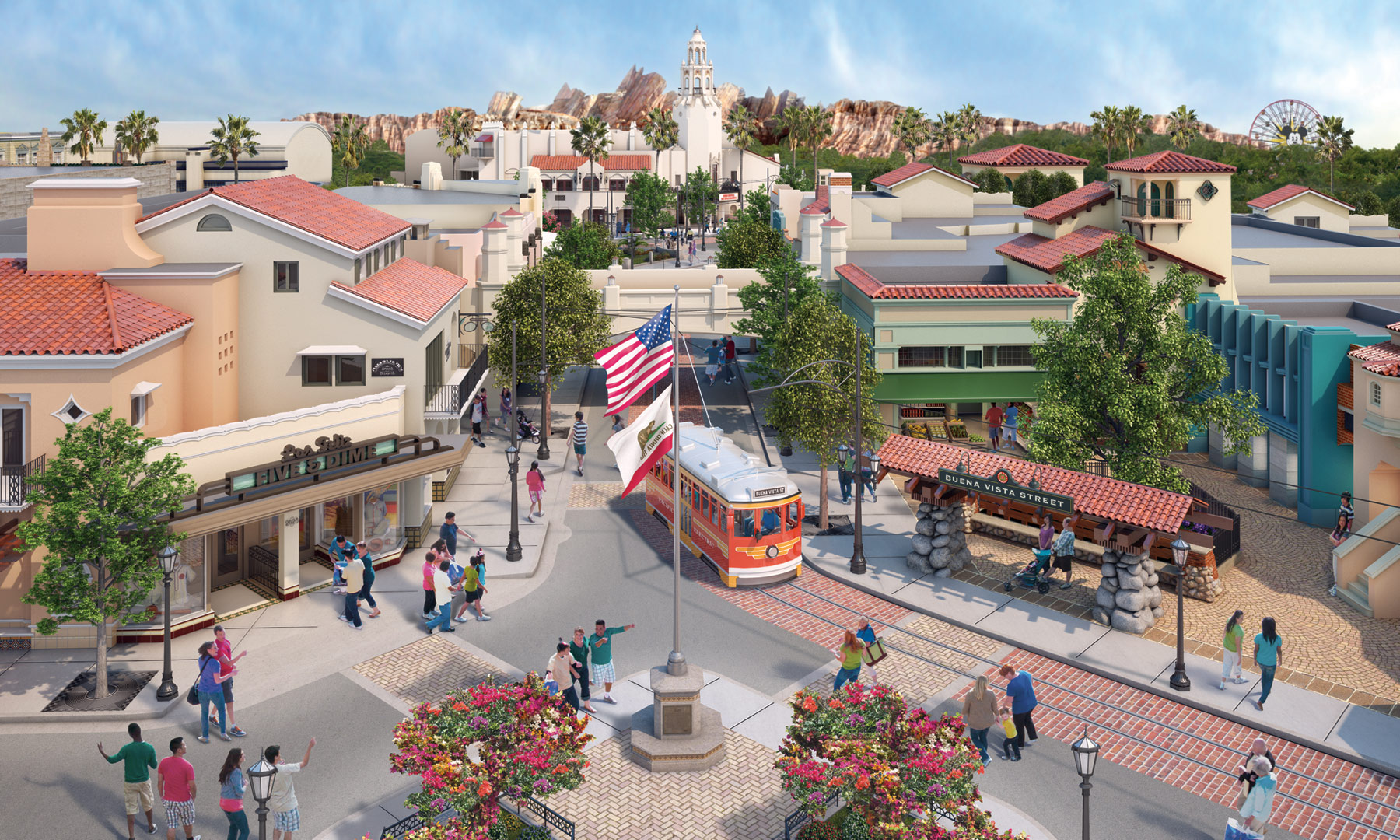
This is Los Angeles in the 1920s and ’30s – a bustling young metropolis of sunset-hued buildings, art deco accents, movie palaces, crooning billboards, clay tiled roofs, elegant department stores, big band music, and the electric optimism of the age. It’s no accident that Buena Vista Street encapsulates the look and feel of a Los Angeles neighborhood in 1923. This is the world of new beginnings that Walt Disney himself stepped into when he arrived in California that summer, with “a suitcase and a dream.”
Weis explained in The Imagineering Story, “[…] the brainstorm of completely tearing out the main entrance and coming into a world Walt might’ve seen when he first came to Los Angeles [was to take you to] a completely different place, immersing you in all the sound and music and everything about that era. It really was intending to take us emotionally into this park as the first act.

“For a lot of people here, Walt was gone before they were born, and they still have that emotional connection from the years of going to Disneyland and being connected to the company. And so that interest has tended to hold that relationship and that emotion from people as they go down the street. And remember, not only do they enter [through Buena Vista Street], but it’s also the last act; the last thing you see. It’s the welcome in and the kiss goodnight. So it has to be really perfect.”
It’s not just that Buena Vista Street complements Main Street rather than intentionally contradicting it; it’s that these two lands tell a story in their own right. After all, when you begin at Disneyland’s Hub and walk down Main Street toward the Train Station, you’re inhabiting dreamy memories of a turn-of-a-century Midwest town, newly alight with the electric lightbulb. Then, when you cross the Esplanade and pass under the Pan-Pacific gates, you’ve traveled two decades and a half-a-country away, literally following in Walt’s footsteps; living Walt’s California adventure.
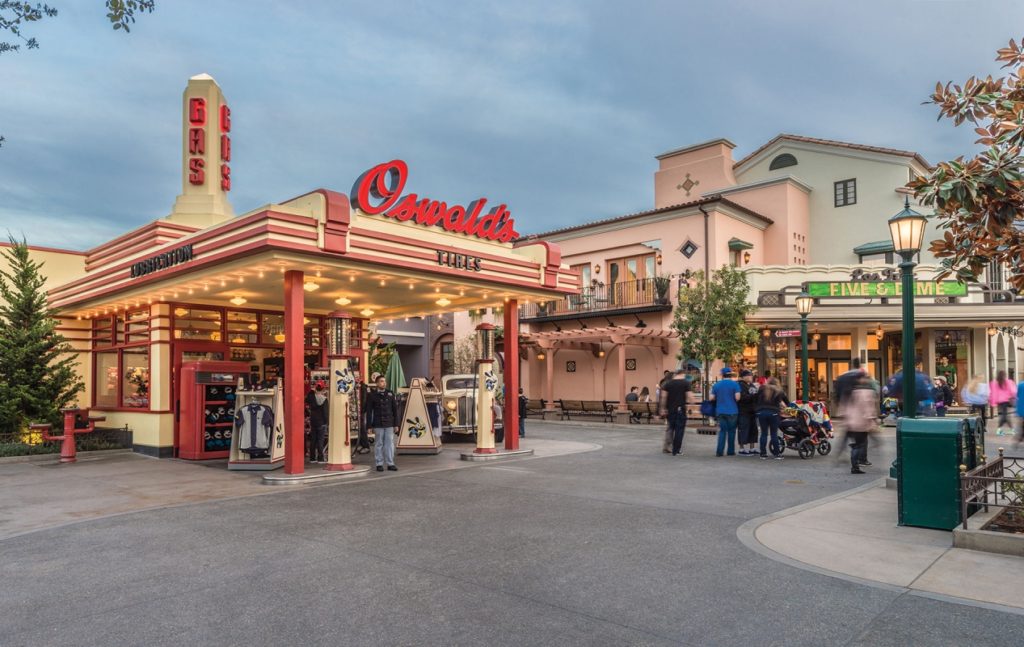
Speaking of Walt’s story, just inside the gate resides Oswald’s Super Service – a gas station with a lucky little rabbit with royal blue shorts as its mascot. The truth is, this is Oswald the Lucky Rabbit – one of Walt’s first cartoon characters. After Walt lost the rights to his own character to Universal in 1928, he and Ub Iwerks reworked the concept to create Mickey Mouse. (It wasn’t until 2006 that Bob Iger decided to get Oswald back, famously trading sportscaster Al Michaels from Disney’s ESPN to Universal’s NBC Sports in exchange for the character!)
Not only is Oswald’s Super Service stocked exclusively with Oswald merchandise, but by way of the period-appropriate Oswald, Disney has set up a clever dichotomy between Disneyland and the new California Adventure. While “Mouse Ears” have been common head-toppers at Disneyland since 1955, only California Adventure sells “Rabbit Ears.” Likewise, knit plush Mickeys may populate the Emporium on Main Street, but knit plush Oswald’s can only be found on Buena Vista Street!
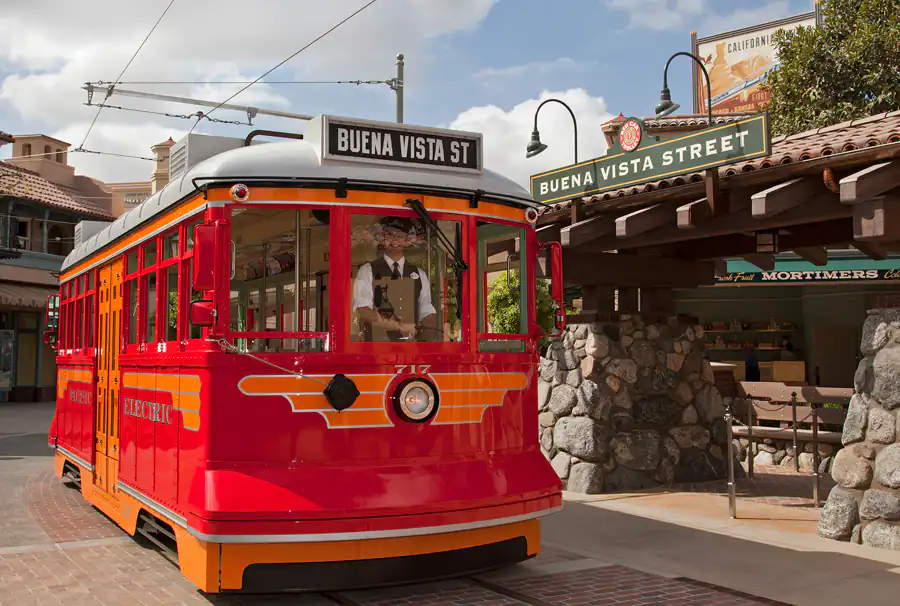
Across the plaza, the Red Car Trolley boards from a craftsman cable car stop, offering one-way trips to Hollywood Blvd. and the Hollywood Tower Hotel. A Californian complement to the horse-drawn carriages and sputtering motorcars of Main Street, the tranquil Red Car glides down the road, guided by overhead electric wires (which, by the way, aren’t real, but were erected throughout Buena Vista Street and Hollywood Land to further the illusion.)
The Red Car dings down the red-bricked center of the street, effortlessly gliding beneath the Monorail. Once disguised as a cartoonish interpretation of the Golden Gate Bridge, the Monorail’s overhead track is now the Glendale-Hyperion Bridge – a recreation of the arch bridge in Atwater that Walt drove over each day en route to his Studio on Hyperion Ave (birthplace of Mickey Mouse and Snow White and the Seven Dwarfs).
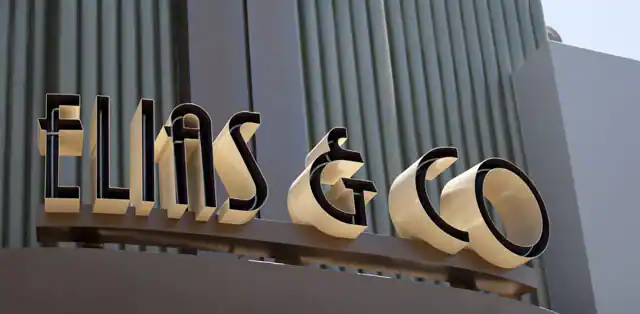
Main Street has its Victorian-stylized Emporium; “DCA 1.0” had the corrugated steel Greetings from California. But at the new California Adventure, the main retail space along Buena Vista Street is Elias & Co., a pastiche of elegant, upscale department stores of the 1920s. Here, amid art deco accents and great crystal chandeliers, you’ll find the park’s shopping headquarters, as well as smaller off-shoots like Big Top Toys and Julias Katz & Sons home decor shop (named for Julius the Cat from Disney’s 1920s Alice Comedies.)
Similar odes to Walt Disney and his early animation can be found at Mortimer’s Market fruit stand, Kingswell Camera Shop recalling Walt’s first apartment on Kingswell Ave., and Clarabelle’s Hand-Scooped Ice Cream named for the beloved cow who served as Minnie’s best friend in Disney’s 1920s animated cartoons.
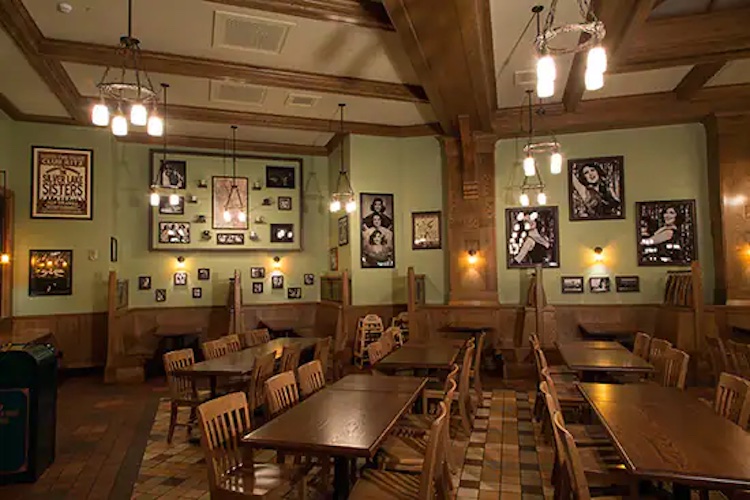
At the end of the street resides Buena Vista Street’s quick service eatery and in-park Starbucks (and allowed the rare exception of using the chain’s original brown-and-brass siren logo, at that), the Fiddler, Fifer, and Practical Cafe. Animation fans may recognize the trio as the names of the Three Little Pigs in Disney’s 1933 adaptation. But in-universe, Fiddler, Fifer, and Practical are the nicknames of the three Silver Lake Sisters, whose photographs can be found throughout the warm, earthy coffee shop interior.
So beloved are the Silver Lake Sisters here in the mythology of Buena Vista Street that you’ll find screen-printed posters advertising their performances across Southern California… including, for example, their legendary one-night-only appearance at the Hollywood Tower Hotel’s Tip Top Club – a full decade before the otherworldly events that we know are doomed to transpire there in 1939…
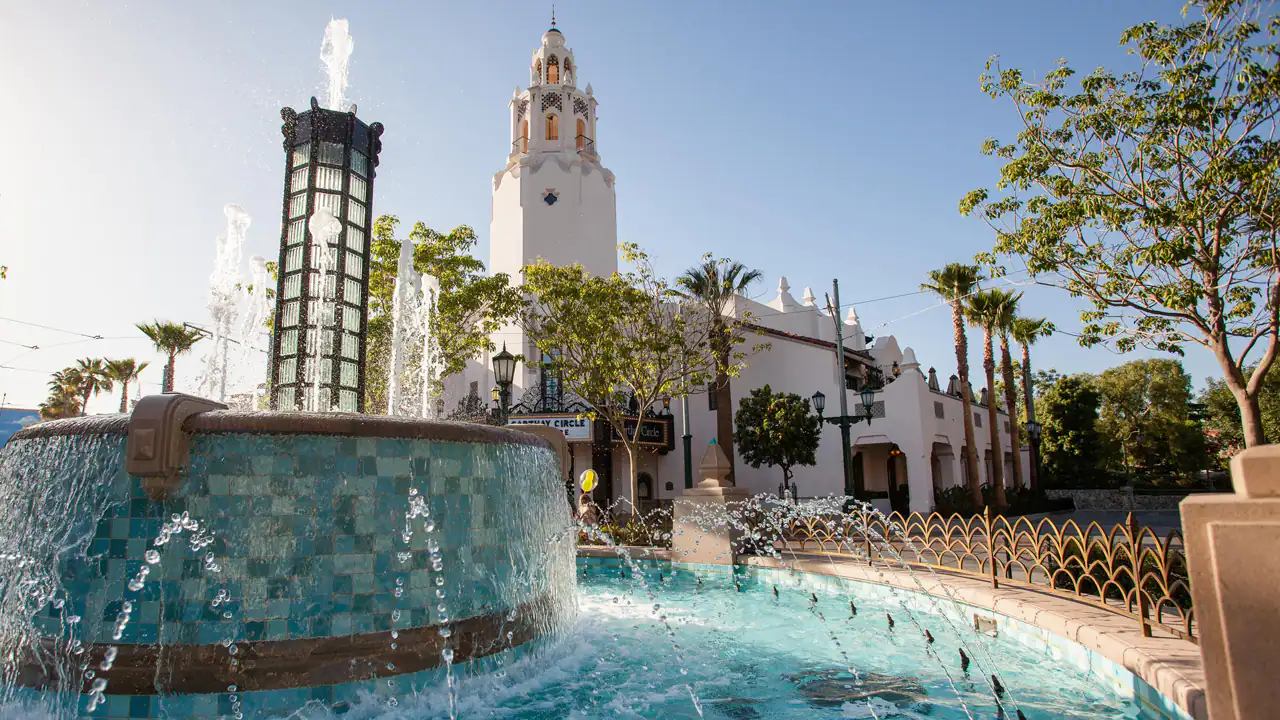
But here in the Roaring ’20s, that’s a long way away. Instead, the optimism and excitement of a young Southern California awaits. And rising at the end of Buena Vista Street resides California Adventure’s new park icon, meant to embody that spirit. Literally and figuratively standing opposite Sleeping Beauty Castle is the Carthay Circle Theater – one of the most legendary of Hollywood’s Golden Age movie palaces.
Of tremendous importance to California history, Walt’s story, and the film industry, Los Angeles’ iconic Carthay Circle Theater is where Walt risked it all to premier the world’s first full-length animated feature film: Snow White and the Seven Dwarfs. Not only is the glowing recreation of this old Los Angeles landmark a stunning piece of architecture… it’s also a worthy counterpart to Sleeping Beauty Castle – genuine Californian “castle,” and a deserving icon of the reborn park.
Inside the Theater resides the Carthay Circle Lounge as well as reception for the Carthay Circle Restaurant – a fine-dining, full service eatery housed on the Theater’s second floor, beautifully and memorably using Snow White backgrounds as murals within.
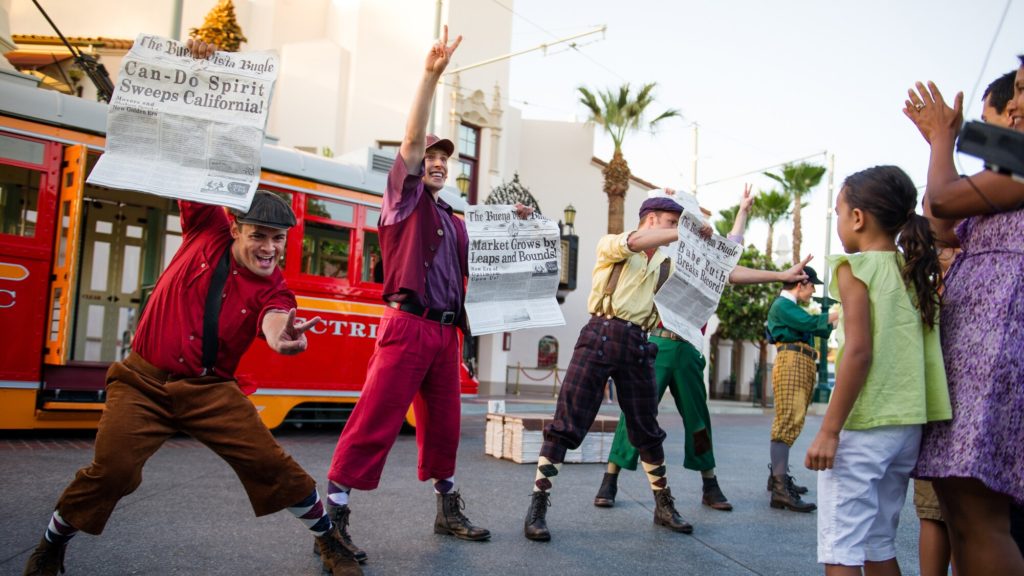
Throughout the day, as the Red Car glides around Carthay Circle, it hums to a halt, signaling the arrival of the Red Car Newsboys – a live street show that brings Buena Vista Street to life. Singing songs from Disney’s Broadway hit Newsies, these 1920s paper boys unfurl newspapers and call out, “”Extree! Extree! Read all about it! Can-do spirits sweeps California!”
Likewise, once in a while the fountain at the center of Carthay Circle quiets as Five and Dime roll up. Hailing from Chicago, this six piece musical act (five musicians and “Dime” on vocals) made their way to Los Angeles via Route 66, aiming to make it big in the local scene. It’s the kind of world-building, in-universe entertainment that’s rarely seen outside of Disney’s top tier efforts… and yet here it is, at California Adventure!
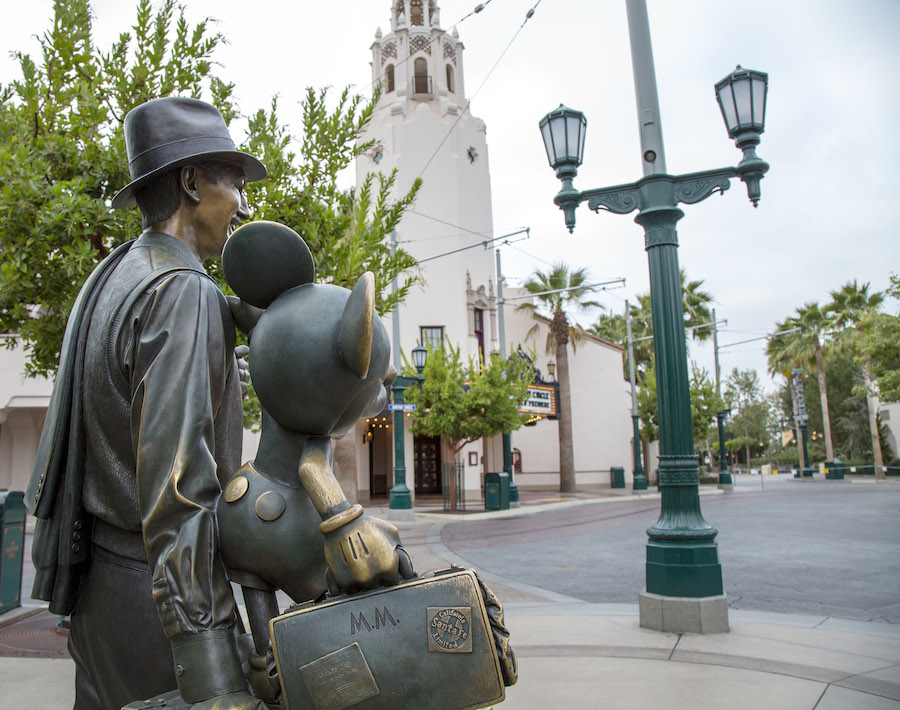
It’s fitting that while Disneyland features the iconic Partners statue of an older Walt and Mickey looking back together, surveying their life’s work, California Adventure instead features an appropriate equivalent: a sculpture of a young Walt and an early, pie-eyed Mickey, newly arrived in California with luggage in hand, gazing up at the Carthay Circle Theater like a beacon. The statue’s name? Storytellers.
Being here on this street – a dynamic, electric, sunset-colored cityscape – you can’t help but feel the electricity of optimism and transformation that’s overcome California Adventure. Buena Vista Street feels so obvious as the opening act of a park meant to celebrate the Golden State. It’s an ode to California; to Walt; a complement to Main Street; a narrative starting point for every land to follow.
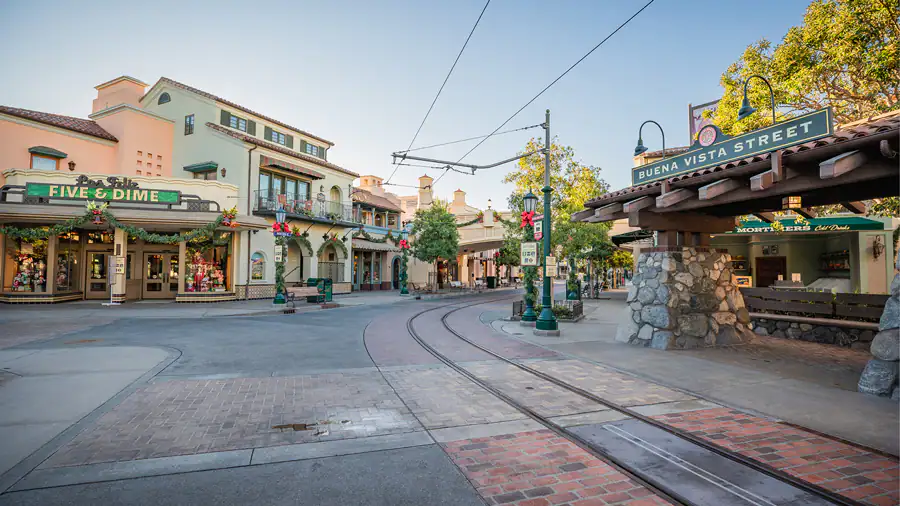
But most importantly in retrospect, it’s also a unlikely and rare anomaly. Designed five years earlier, it would’ve Sunshine Plaza; five years later, it would be Shanghai Disneyland’s Mickey Avenue – an IP-infused, cartoon-proportioned, franchise-friendly counterpart. Maybe, from the 2020s, it even seems possible that Buena Vista Street’s conversion into Mickey Ave. could be announced at any moment… Here, though, in 2012, it’s perfect.
And now, having looped around Five & Dime as they perform at the fountain, the Red Car Trolley glides around Carthay Circle and between two oriental pillars to enter the park’s next reborn land… Ready to hop aboard for a full-circle tour of the new California Adventure? Hold on tight, because while our look at its “new” lands continues on the next page, the lands that Disney Imagineers crafted during the park’s redesign just a few years ago are already on the move once more… some say, toward another derail…
Enjoy it while you can as we tour through the reborn park as it appeared in 2012, and then catch up on what’s happened since… Read on…


